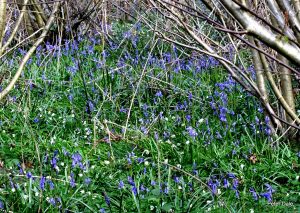If you have a nest box or any nest in your garden, this might be a good time to keep a regular watch and record dates of bringing in nesting materials, food, and removal of faecal sacs and later fledgling. When baby birds are being fed it is amazing to see how frequently the adults come to the nest. You can count how many times in say 10 minutes. If you know where the nest boxes are around the village you could also record activity there.
minutes. If you know where the nest boxes are around the village you could also record activity there.
Keep an eye on the sky. There are many reports of buzzards (over the Rife, from David Bettiss) and kites and a pair of buzzard are probably breeding again on the west side of the East Preston/Ferring gap.
Bird song is brilliant at the moment. Check you can identify the song of robin and blackbird. You can see them singing to confirm identity. Try to learn one song at a time. Small migrants are starting to arrive: listen out for the first of the warblers, the chiffchaff. This is the easiest song to identify because all they do is go ‘chiff’ and ‘chaff’, like a pendulum. Don’t confuse with a great tit which goes ‘teach-er, teach-er”.
Graham has reported butterflies in his garden: a comma, peacock and brimstone Brimstones are pale yellow, males brighter than females. I have seen small tortoiseshell and red admiral. Any records of small tortoiseshell would be useful.
Graham Tuppen has evidence of hedgehogs in his garden and he says that bluebells are just beginning to come out in Clapham Woods together with the lovely wood anemones.
Being somewhat confined, might be a good time to start doing some daily records of observations in your garden. You might be surprised at what turns up! A note book and identification books are all you need whilst sitting in the sun.
